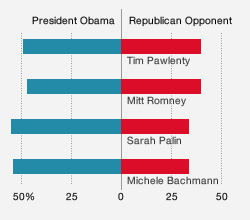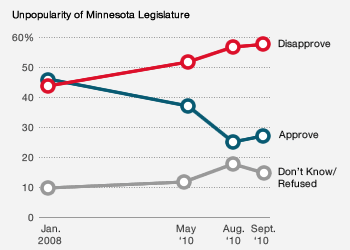Services
MPR News-Humphrey Institute Poll
Obama could see trouble in 2012 in Minnesota
Minnesota Public RadioSeptember 29, 2010
President Barack Obama leads Minnesota Governor Tim Pawlenty and former Massachusetts Governor Mitt Romney in a potential 2012 presidential matchup, according to the latest MPR News-Humphrey Institute Poll. But Obama is unable to clear 50 percent support, managing a relatively modest 9-point lead over Pawlenty and 7 points over Romney.
The poll — conducted by Minnesota Public Radio News and the Humphrey Institute at the University of Minnesota — surveryed voters' preferences in the governor's race and approval ratings of politicians. See the full poll report and methodology, or read MPR News reporter Mark Zdechlik's report on this portion of poll.
Presidential Politics in Minnesota
 Republicans' chances to win Minnesota in the 2012 presidential elections will depend on who they nominate. President Barack Obama's bid for reelection faces competitive challenges from Republicans Gov. Tim Pawlenty and former Massachusetts Gov. Mitt Romney in Minnesota.
Republicans' chances to win Minnesota in the 2012 presidential elections will depend on who they nominate. President Barack Obama's bid for reelection faces competitive challenges from Republicans Gov. Tim Pawlenty and former Massachusetts Gov. Mitt Romney in Minnesota.
While all three are supported by more than 8 out of 10 of their fellow partisans, but there is a potential omen of bad news for Obama: Pawlenty and Romney are drawing support from more than 6 out of 10 of the 60 percent of likely voters who think the country is on the wrong track.
Other Findings
- • Minnesota voters have awoken from their summer slumber. More than 8 out of 10 Minnesotans are interested in the November elections, a substantial increase that is being propelled by the energizing of formerly turned-off Democrats.
- • In legislative races, 50 percent of likely voters would prefer an alternative to incumbent members of Congress while the Democratic candidates for the Minnesota Legislature enjoy an 11-point advantage against their Republican opponents.
- • A majority of voters favor Arizona's strict immigration enforcement law and a plurality oppose same-sex marriage, but these issues have fallen off the agenda, drawing little voter interest.
Ominous Signs for Obama
Despite the political challenges facing Obama, he does have a notable and surprising strength: the economy and jobs, which are singled out by 55 percent of voters as the single most important national problem -- four times or more concern than for any other issue.
 Among the majority who are primarily concerned about the economy and jobs, a majority of these voters prefer Obama to Pawlenty, 52 percent to 37 percent. Pawlenty enjoys a similar advantage on the budget deficit, but only 14 percent of likely voters rank it as the top national problem.
Among the majority who are primarily concerned about the economy and jobs, a majority of these voters prefer Obama to Pawlenty, 52 percent to 37 percent. Pawlenty enjoys a similar advantage on the budget deficit, but only 14 percent of likely voters rank it as the top national problem.
Wither Social Issues?
Social issues, such as same-sex marriage and immigration, are not registering as important political issues in Minnesota's 2010 general election battles despite the lopsided views of voters. Less than 5 percent of voters ranked same-sex marriage, abortion, or immigration as the single most important issue facing the state. This disinterest in these issues reflects the tendency of the gubernatorial candidates to ignore them in public.
Even as social issues have faded in the election, Minnesota voters harbor strong views toward them. By a 52 percent to 33 percent margin, voters favor the Arizona immigration law.A plurality also opposes allowing gay and lesbian couples to marry, including 34 percent of Democrats and 52 percent of independents.
Unpopularity of Minnesota Legislature
The renewed interest of Democrats in the November elections has revived their party's prospects for maintaining the majority in the Minnesota Legislature.
 When Minnesota voters are asked whether they would support an unnamed Democratic or Republican candidate for the Minnesota Legislature in November, 48 percent expressed support for the Democrat and 37 percent for the Republican (15 percent did not offer a preference).
When Minnesota voters are asked whether they would support an unnamed Democratic or Republican candidate for the Minnesota Legislature in November, 48 percent expressed support for the Democrat and 37 percent for the Republican (15 percent did not offer a preference).
The Democrats edge has emerged despite strong disapproval of the DFL-dominated Minnesota Legislature; 58 percent currently disapprove of its performance, similar to its rating in late August. More than 6 out of 10 Republicans and Independents disapprove of the way the legislature is handling its job, and even a majority of Democrats — 53 percent — disapprove.
About the survey and methodology
This survey is a collaboration between Minnesota Public Radio News and the Center for the Study of Politics and Governance at the University of Minnesota's Humphrey Institute of Public Affairs. The survey was analyzed by the Center. The research team was Lawrence R. Jacobs, the center's director, and Joanne M. Miller, associate professor of political science. Charles Gregory provided research assistance.
The survey was fielded by the Information Specialists Group (ISG) and is based on a landline random digit dial survey in Minnesota. ISG called a sample of telephone exchanges that was randomly selected by a computer from a list of active residential exchanges within Minnesota. Within each exchange, random digits were added to form a complete telephone number, thus permitting access to both listed and unlisted numbers. Within each household, one adult was selected to be the respondent for the survey.
 As is common with public opinion surveys, the data were weighted. In the first stage, the data were weighted based on the number of potential survey respondents and the number of landline telephone numbers in the household. In the second stage, data were weighted according to cell phone usage, as well as gender, age, race, and Hispanic ethnicity to approximate the demographic characteristics of the population according to the Census.
As is common with public opinion surveys, the data were weighted. In the first stage, the data were weighted based on the number of potential survey respondents and the number of landline telephone numbers in the household. In the second stage, data were weighted according to cell phone usage, as well as gender, age, race, and Hispanic ethnicity to approximate the demographic characteristics of the population according to the Census.
Results are based on a model that accounts for the likelihood of a respondent voting based on the following factors: self-reported probability of voting in the upcoming election, voting in the 2006 gubernatorial election as reported by the respondent, interest in the 2010 election, and whether the respondent reported being registered to vote. The model estimates a turnout of 58%, which we expect to increase during the fall as the campaign heats up and interest in the election increases.
Between Sept. 22 and Sept. 26, 2010, 750 likely voters living in Minnesota were interviewed by telephone. The margin of error ranges between +/-3.6 percentage points based on the conventional calculation and +/-5.1 percentage points, which is a more cautious estimate that takes into account design effects, in accordance with professional best practices.
The conventional calculation of the margin of sampling error is primarily based on the number of respondents and, critically, assumes that all respondents selected for interviewing were actually reached. More infomation about the poll's methodology is available in the complete poll PDF.
In The Spotlight
-
The Current Music Blog
Your daily note for good music, news and pop culture. With attempted jokes.


